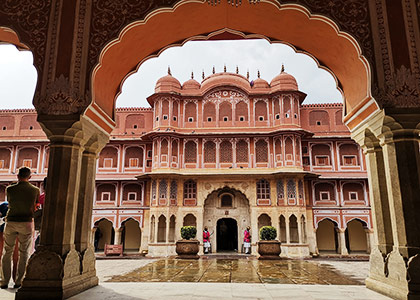Jaipur City Palace: Things You Should Know & Remember
A land of warrior and kings, Rajasthan is home to an array of monuments and structures which are of huge historical importance and national too. Jaipur, the capital city of the Indian state Rajasthan, is home to one of the famous royal residents of the city, the Jaipur City Palace.Jaipur, one of the oldest planned cities of India, was built based on the ideals of Vastu Shastra (Indian Science of Architecture) by Maharaja Sawai Jai Singh II along with the help of renowned Indian architect of that time Vidyadhar Bhattacharya. The city palace was also built by Maharaja Sawai Jai Singh II after the capital was transferred from Ajmer to Jaipur in 1727. Now it finds itself as one of the top tourist locations of the city.
Jaipur City Palace Entry Timings & Ticket Prices:
There are also composite tickets that are valid for multiple days and include the entry permit for Jaigarh Fort. The department of tourism in Jaipur also organizes special night tours for the palace. There are also guides available (for a fee of course) of various languages for anyone wants to really soak in the history of the place.
|
|
|
Things to See:
Chandra Mahal: This remarkable architectural structure is located at the west end of the city palace. The architecture is a mixture of Mughal and Rajput architecture, however, the hints of European architecture can be found in every curve of this edifice of wonder. The structure of peacock that welcomes you through the Mor Gate is supposed to represent autumn season along with three other gates like the Lotus Gate for the summer season, Lehriya Gate for spring season, and the Rose Gate for the winter season. The design and grandeur of the gates are a treat to eye which inspire not only awe but sheer pleasure.The Chandra Mahal building is divided into seven floors, all having unique names like Sukh Niwas, Mukut Mahal, Rang Mandir and so on. Most of the palace is resided in by the royal family that lives here and the ground floor is made into a museum containing royal artifacts, manuscripts and other historical and family items. All the sections have their own unique designs and concepts with their individual eccentric colour schemes.
Pritam Niwas: This is situated in the inner parts of the City Palace. It includes four small gates which lead to the Chandra Mahal. The gate is decorated with illustrations and allegorical designs that represent the four seasons and the Hindu deities Lord Vishnu, Lord Shiva Parvati, Lord Ganesha, and Goddess Devi.
Diwan–e–Aam and Diwan–e–Khas: Literally translating to the ‘Hall of Public Audience’ and the ‘Hall of Private Audience’ respectively, they are now used as museums to exhibit special and royal possessions. The Diwan–e–aam contains the two famous silver vessels, certified by Guinness Book of World Records as the largest silver vessels in the entire world, which were used by the Maharaja to store and carry water for his trip to England. On the other hand, Diwan–e-Khas is a place of splendor and magnificence which is now converted into an art gallery. There are exhibitions of miniature paintings, ancient texts, embroidered rugs, Kashmir shawls, and carpets. Handwritten original manuscripts of Hindu scriptures of the forgotten times and the holy and prestigious Royal throne known as ‘Takht-e-Rawal’, is placed here for display.

Jaipur City Palace - Magnificent Architecture
|
|
|
Apart from these, some other places of attraction inside the palace ground are Mubarak Mahal, Maharani Place or the Residency of the Queens which has now been turned into a museum to showcase weapons of past times, Bagghi Khana which contains the chariots and the famous European cab gifted to the royalty by the Queen of England herself. You can also visit the Govind Dev Ji Temple which is hardly a 500 meters walk from the City Palace complex.How to reach:City Palace is approximately 12 kilometres (7.5 miles) from Jaipur Airport and 4.5 kilometres (2.8 miles) from Jaipur Railway Station. It is well connected by cabs and also auto-rickshaws from almost every hotel and road.Time to Visit:Prime time to visit Jaipur or Rajasthan in that sense is from October to March when it is relatively cooler than the scorching heat of the summer. To avoid the rush, try to hit the city palace in the mornings or in the evenings, perhaps a sunset view from the walls of an old and forgotten world will welcome you unexpectedly.
|
A trip to Rajasthan is incomplete without a visit to its capital, the ‘Pink City’, which it derives from the colour of the buildings that crowd the lanes of this regal city. Jaipur and its famed City Palace attract tourists from all over India and the world. The history that it resonates with, the architecture, all comes together to make the Jaipur City Palace one of the top tourist locations of Rajasthan.


